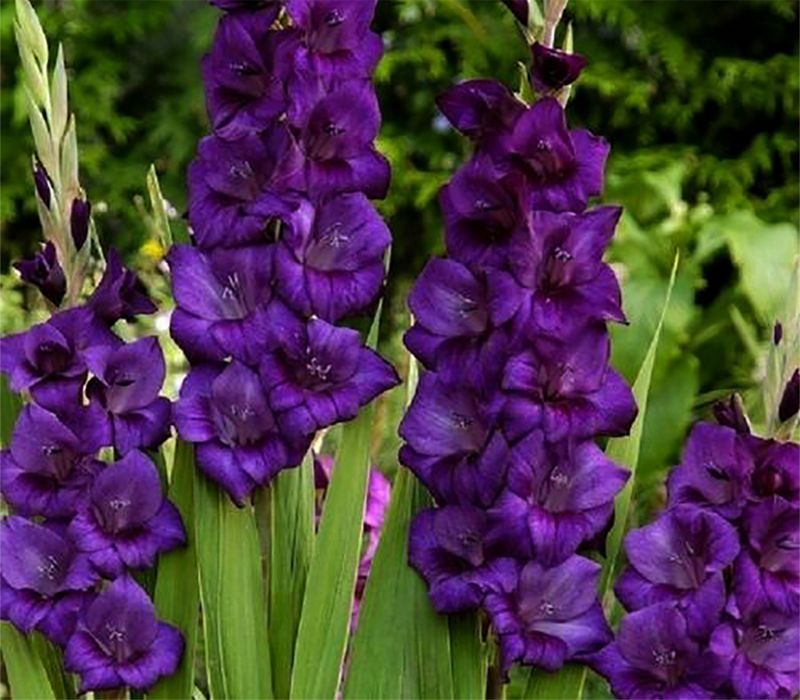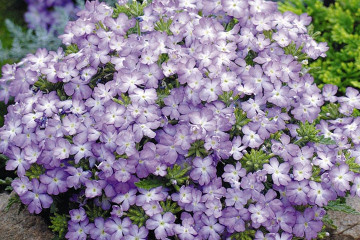Gladioli planting and growing
Content:
Gladiolus, otherwise called the skewer, is a perennial corm plant that is grown in Europe, Asia and Africa. Some species come from Siberia. Due to the characteristic shape of the leaves, the flowers were named "Gladius", which is Latin for "sword".
Characteristics of a gladiolus
The first of the tubers to sprout are leaves. Flat, pointed upwards, they close, adding stability to the peduncle. The plant blooms on a straight, unbranched stem. From an adult bulb, 2-3 peduncles may appear. The inflorescence is spicate, depending on the variety, one-, two-sided or spiral-shaped. In some varieties, garden gladioli can reach a height of 2 m.
Gladiolus seeds ripen in a three-leaved box.
Popular varieties of gladioli
More than 5,000 existing varieties of garden gladioli are annually replenished with new varieties. The International Classification System provides detailed information on each variety.
According to the diameter of the flowers, gladioli are divided into:
- miniature (up to 6.5 cm);
- small (6.5-9 cm);
- medium - (9-11.5 cm);
- large - (11.5-14 cm);
- giant - (over 14 cm).
To navigate how to plant gladioli by flowering time, varieties are divided into:
- early (June),
- medium (July),
- late (August - September).
Gladioli can take the form:
- flat not corrugated;
- corrugated;
- super-crimped.
The color range of varieties is also very diverse:
- pink and its shades have almost a third of varieties (Innosens, Pink and Spen, Invitate, Rose Spire);
- white (Ave Maria, Apostle Peter, Baltais Rits);
- red (Robin, Melody, Georgette);
- salmon orange (Seraphin, Freezled Coral Lace, Airlie Highlight);
- yellow (Leonora, Joyce);
- lilac (Costa, Lavender Masterpeace, Vera, Lynn, Elizabeth the Queen, Imposant);
- purple (Faro, Astro, The Magic Flute, Blue River);
- burgundy (Royal Stewart, Dark Brilliance, King De Vid);
- purple (Blue Bird, Blue ornament);
- smoky brown (Chocolate Girl, Amigo, Satin Grand, Bison, Velvet Night);
- green (Bambi, Green Woodpecker, Green Ice, Peacock Feather, Spring Awakening);
- ink blue (Belle de Noir, Violetta).
The peculiarity of the color of gladioli gives room for selection work. There are many varieties that combine not only a smooth gradient of colors, but also contrasting strokes and spots in the throat. Breeders are also looking for a way to create varieties with a clear blue color.
Breeding species of gladioli
You can propagate the variety of gladiolus you like by sowing tubers, dividing the corms, seeds and seedlings.
Seeds
This method is used by breeders to obtain new varieties. Flowers grown from seeds may not inherit the varietal traits of the parent plants. Sowing is carried out at the end of winter in a greenhouse.
How to plant seeds:
- The seeds are soaked in a solution of sodium humate solution (0.01%) for 2-3 hours.
- For soil use: leaf humus 2/3, river sand 1/3.
- With the arrival of spring, containers with seedlings are moved to a greenhouse or garden (open ground with a container).
Tubercuffs
The varieties also differ in the number of tubers produced during the season. Some form up to a hundred children or more (Pink Harmony, Fireball), while others give out only 10-15 (Oscar) tubers per year by the fall.
The number and size of tubers depend on the conditions:
- temperature regime;
- soil moisture;
- the length of the growing season.
Early varieties have a large baby, in later ones it is smaller.
On average, tubers develop up to three months, coinciding in time with seed ripening. Ripe babies are well separated from the mother's corm. For planting, they are sorted by size. Large ones (1-2 cm) can bloom earlier in the summer, and small ones only after three years.
The variety can be quickly propagated by sowing large tubers in a pot or box in early spring. Like seeds, with the arrival of heat, they are taken out to a greenhouse or installed in a common garden bed. As a result, young plants have more time for growing and have time to form replacement bulbs. Can be used to germinate babies:
- peat-humus pots;
- peat briquettes;
- eggshells.
This method will allow you to transplant plants into the soil without damaging the roots.
Seedlings
Gladiolus seedlings can be obtained from cuttings. For this, sprouts are selected that do not exceed 15-16 cm, and are placed in water for rooting. The resulting planting material is grown in river sand of a coarse fraction under a film in a greenhouse. The rooted shoot is able to form an inflorescence and replacement corm.
Basic rules for growing gladioli
Growing flowers is not difficult if you take into account the rules of agricultural technology.
Seat selection
Gladiolus needs good lighting, light nutritious soil, and protection from the wind.
For planting, choose a place that is even with a slight slope (50 °) to the south, this will not allow excess moisture to linger and receive additional heat for the corms.
When can you plant
Gladioli can be planted when the soil warms up to 10 ° C, unpeeled tubers are comfortable at 5-6 ° C. If planted earlier, the corms will not be able to germinate, and with excessive moisture, they may die. For the Middle Lane, there is a recommendation - to plant gladioli from the last decade of April to the second decade of May. In a flowerpot or container, flowers can be germinated from the end of February.
What is the depth to make the beds
If there are a lot of bulbs, then the best advice is to make beds. With their width of 1-1.2 m, it is more convenient to care for the plants. It is advisable to arrange the beds in length from west to east or along the slope. It is better to plan rows across the beds. Since gladioli need to be planted different in size, this method will allow the flowers to receive uniform illumination, the soil between the rows also warms up equally.
The planting depth is determined depending on the size of the tuber:
- large (1 cm and more) are deepened by 4-5 cm;
- medium (0.5-2 cm) deepened by 3-4 cm;
- small (up to 0.5 cm) cover with a layer of soil no more than 2-2.5 cm.
The row length is also calculated based on the number of tubers:
- 40 pieces / 1 m large - the distance between the rows is 25-30 cm;
- 70 pieces / 1 m small - the distance between the rows is about 15 cm.
Planting gladiolus bulbs outdoors
Pre-planting treatment of corms, its purification and prophylactic treatment contribute to early germination (up to 1 week) and an increase in plant immunity.
Preparing the bulbs for planting
Before planting gladioli, the bulbs are carefully peeled, trying not to damage the emerging sprouts that germinate for planting in early and mid-early varieties. The rotten ones, damaged by the fungus, are discarded and destroyed.
A valuable bulb can be salvaged if the damage is minor. Sick tissues are excised, followed by soaking in a solution of potassium permanganate or dusting with crushed activated carbon.
For the prevention of fungal diseases, planting material is processed:
- potassium permanganate;
- succinic acid;
- humate sodium.
Preparing the soil for planting
Flowers will feel best in slightly acidic light loamy soil, sandy loam or in structural chernozem. The landing site must be prepared in the fall. For this, the soil is dug up and humus and manure are introduced. The flower grows well after vegetables, green manure and legumes.
Gladioli care
Gladioli are responsive to grooming. Loosening and mulching the soil, weeding weeds, the use of micronutrients will allow you to get abundant flowering and healthy planting material.
Watering
Water the plant abundantly (10-15 l / 1 m²) so that moisture reaches the roots, which lie at a depth of 40 cm. Water the beds every 10 days between rows so that water does not fall on the leaves. After that, it is necessary to loosen the soil so that the crust formed in the heat does not block the access of the roots to the air.
Weeding
Gladioli should be weeded as they overgrow, once every 3-4 weeks. In overgrown with weeds, slugs multiply rapidly, the lack of air circulation leads to the development of fungal diseases.
Spraying
To increase the decorativeness of the plant, to stimulate the growth of tubercles, foliar feeding is carried out every 2-3 weeks. Flowers are sprayed in cloudy calm weather or in the evening. Considering the structure of gladiolus, soap is added to the solution for adhesion and sprayed on both sides of the leaf.
At the same interval, greens are sprayed after the appearance of 3-4 leaves, watering the soil with drugs for the prevention of diseases.
Garter
To avoid curvature, the plants must be tied up immediately after the peduncles are extended. If the planting was done in rows, they are installed along the edges of the planks, a rope is pulled between them, supporting each flower, or a large-mesh plastic net is installed at a height of about 1 m, guiding peduncles between the cells.
Hilling plants 10 cm in height can replace the garter of low gladioli. The procedure is carried out with the appearance of 4-5 sheets.
Top dressing
During the growing season, the plant needs additional fertilizing to obtain the necessary substances, micro and macro elements. Fertilizers:
- nitrogenous is carried out with the appearance of 2-3 true leaves;
- nitrogen-potassium-phosphorus is carried out when 5-6 leaves appear;
- potassium-phosphorus is carried out with the appearance of buds on the peduncle.
It is more efficient to add minerals in liquid form, they are absorbed faster by the root system. Before and after the procedure, the soil must be watered with plain water.
Cutting flowers
It is better to cut flowers in the early morning or after sunset with the appearance of color in the lower 1-2 buds, the opening of the first flower, if it is planned from transportation.When cutting off the peduncle, it is necessary to leave at least four leaves, they are necessary for the maturation of the corms.
It is necessary to cut off the inflorescence with a sharp knife, being careful not to damage the leaves.
Possible growing problems
In the process of growing gladioli, a gardener may encounter about 15 types of fungal and viral diseases. The plant is parasitized by more than 55 varieties of parasites. It is impossible to completely get rid of threats; as a preventive measure, proper care and the choice of resistant varieties are recommended.
Pests
Common pests that can be found in any country house:
- thrips;
- cabbage scoop;
- bear;
- onion tick;
- wireworm;
- slugs.
Diseases
Knowing how to properly care for gladioli outdoors will help avoid most infectious and viral diseases. Reproduction of pathogens occurs under adverse weather and soil conditions. All parts of the plant are attacked by rot of different types:
- fusarium dry rot;
- sclerotinosis;
- botrytosis;
- brown heart rot;
- septoria;
- penicillous corm rot.
Viral diseases of the flower can destroy a large number of plants due to the speed of spread. Planting and caring for gladioli in the open field provides for the prevention of viral and fungal diseases:
- spraying with fungicides during the growing season;
- compliance with storage conditions;
- material processing before planting.
Signs of improper care
Signs of a dysfunctional plant appear in its appearance:
- deformation of leaves and peduncles;
- changes in foliage color;
- the appearance of spots, bloom;
- slow plant growth, some may be difficult to germinate.
Competent care of gladioli will allow you to achieve full, friendly flowering. Given the varietal characteristics, it can be extended up to two months. How to do this is described above.





















